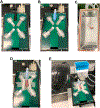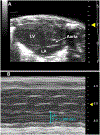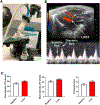Echocardiographic Characterization of Left Ventricular Structure, Function, and Coronary Flow in Neonate Mice
- PMID: 35467668
- PMCID: PMC9155257
- DOI: 10.3791/63539
Echocardiographic Characterization of Left Ventricular Structure, Function, and Coronary Flow in Neonate Mice
Abstract
Echocardiography is a non-invasive procedure that enables the evaluation of structural and functional parameters in animal models of cardiovascular disease and is used to assess the impact of potential treatments in preclinical studies. Echocardiographic studies are usually conducted in young adult mice (i.e., 4-6 weeks of age). The evaluation of early neonatal cardiovascular function is not usually performed because of the small size of the mouse pups and the associated technical difficulties. One of the most important challenges is that the short length of the pups' limbs prevents them from reaching the electrodes in the echocardiography platform. Body temperature is the other challenge, as pups are very susceptible to changes in temperature. Therefore, it is important to establish a practical guide for performing echocardiographic studies in small mouse pups to help researchers detect early pathological changes and study the progression of cardiovascular disease over time. The current work describes a protocol for performing echocardiography in mouse pups at the early age of 7 days old. The echocardiographic characterization of cardiac morphology, function, and coronary flow in neonatal mice is also described.
Conflict of interest statement
Disclosures
The authors have nothing to disclose.
Figures





References
-
- Nagueh SF et al. Recommendations for the Evaluation of Left Ventricular Diastolic Function by Echocardiography: An Update from the American Society of Echocardiography and the European Association of Cardiovascular Imaging. European Heart Journal: Cardiovascular Imaging. 17 (12), 1321–1360 (2016). - PubMed
-
- Lang RM et al. Recommendations for cardiac chamber quantification by echocardiography in adults: an update from the American Society of Echocardiography and the European Association of Cardiovascular Imaging. European Heart Journal: Cardiovascular Imaging. 16 (3), 233–270 (2015). - PubMed
Publication types
MeSH terms
Grants and funding
LinkOut - more resources
Full Text Sources
